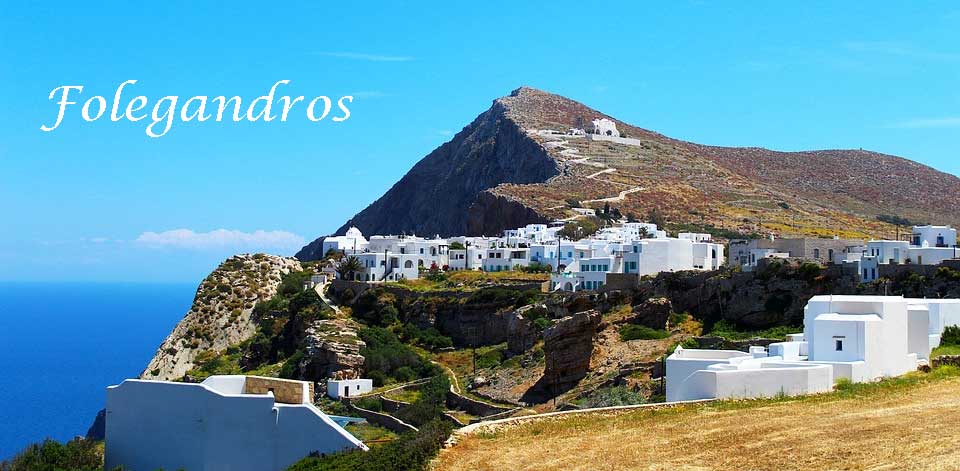What to do in Folegandros ?
What to do

After arriving at the port of Karavostasi, Folegandros will begin to unfold its beauties little by little. All you have to do is wander the cobbled streets of Chora and the narrow streets of the Castle.
Climb the rock of Panagia with the panoramic view of the Aegean, swim in its deserted or crowded beaches, explore nature through the paths that run through every corner Island’s. It is worth tasting the homemade, traditional food in Chora, Karavostasis, Agali or Ano Meria and enjoying the nights with racomela in the squares of Chora.
In addition to walks in the picturesque narrows of the settlement and diving in the deep blue waters, it is also worth exploring the nature and traditions of the island. The wild and rocky landscape of Folegandros combined with the clear blue waters of the sea make up a beautiful scenery that will enchant you.
Come to Folegandros if you enjoy walking, fishing, swimming or just relaxing in traditional tavernas away from the tourist hordes. There’s little else to do here and therein lies the island’s special charm for visitors who want to escape the summer madness of the more frantic Cycladic islands such as Mykonos, Santorini and neighbouring Ios.
Explore Chora and the Castle
You’ll want to explore the island’s medieval capital,Chora, which is one of the most enchanting towns in the whole of the Cyclades. You won’t even notice it from the sea though it’s perched high on a cliff 230 metres above sea level.
The town was built inside a 13th century Venetian kastro (Kastro) and the outside walls of the houses, where villagers still live today, formed part of the defensive enclosure with arched gateways leading into the town.
The traffic-free town is a delightful concoction of narrow cobbled streets lined with sugar cube houses and wooden balconies bedecked with bougainvillea, hibiscus and geraniums.
There are shady squares where you can sit at one of the many cafes and tavernas beneath the lime, almond and pepper trees. Sip an ouzo or raki and practise your Greek phrases on the locals before settling down for lunch at one of the tavernas which offer a surprisingly varied range of excellent home-made dishes.

Dine out in Piatsa and Karavostasis
One of the best restaurants on the island is Piatsa, on the second square past the kastro, which offers some innovative daily specials and a range of vegetarian dishes. O Kritikos, on the third square past the kastro, is the place to go for top quality grilled meat. If you’re a seafood fan head for the port of Karavostassis for lunch – try the local “liokafto” fish dish, fresh lobster or locally caught sea bream.
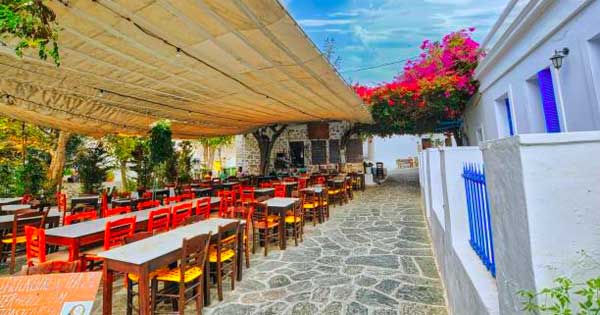
Visit the church of Panagia
Pay a visit to the fairy-tale white-domed church of Panagia which dominates the town from above its ancient walls. The star attraction here is a reputedly miraculous icon of the Virgin Mary which was stolen three times in pirate raids but allegedly floated back to its island home on each occasion. At Easter the icon is taken from the church and paraded through the town followed by a procession of islanders.
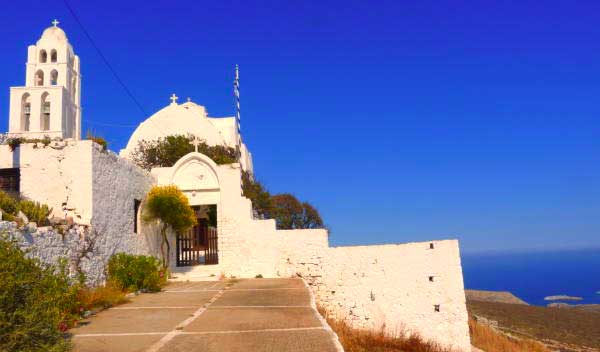
Visit the Golden Cave
From the port you can take a boat to see one of the island’s most interesting features, the Cave of Chrissospilia (Golden Cave) in the cliff wall to the north east of Chora. The cave can also be reached on foot but the scramble is hard work for all but the most hardy of hikers.
It’s one of the most impressive of its kind in the whole of the Cyclades but mercifully has not been turned into a major tourist attraction – it houses some beautiful stalactites and stalagmites and ancient inscriptions, broken pots and human remains have been found here.
The cave takes its name from the golden treasure which the islanders brought here when they took refuge from the pirates who once plagued these waters. The invaders reputedly sealed the cave entrance and set fire to it, leaving only a pool of molten gold.
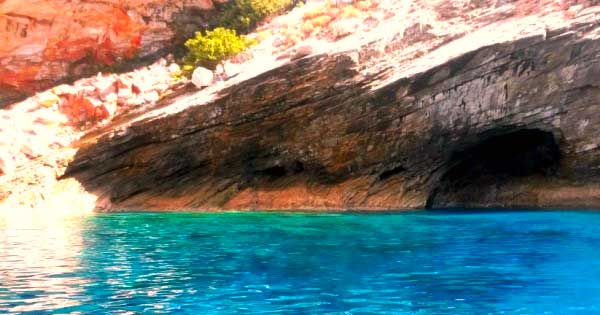
Visit the Folk museum
At the farming settlement of Ano Meria in the north west of Folegandros you can visit the local Folk Museum which gives an interesting insight into the traditional peasant way of life which has existed on the island for centuries. Ano Meria also has some good tavernas where you can sample the local specialty matsata (home-made pasta with rooster or rabbit).

Learn Greek cooking and dancing
The island’s Cycladic School, run by a Greek/Danish couple, gives you the chance to combine your holiday with learning a new skill. The school brings in foreign teachers to run a wide range of one and two week courses in subjects ranging from Greek cookery and folk dancing to painting and yoga.
Walk to Livadi
Livadi is a sparsely populated rural area, with scattered hayfields stretching from the sea inland. It is located 1.5 km from Karavostasis, with easy access to the beach of the same name. The campsite of the same name is also located in the area.
Visit Petousis
Petousis is one of the oldest and smallest agricultural settlements. It is located on the southeast side of the island, 3.5 km from Chora. A 3 km dirt path connects the settlement with Livadi. In Petousi you will find hayfields, paddocks with animals and local farmers.

Visit Ano Meria
In this settlement, you will see the authentic rural life of Folegandros. The houses are essentially small self-contained farms, built to be self-sufficient agricultural and livestock production units. That is why there are no alleys and shady squares – however there are some attractions such as the Aspropounda Lighthouse standing proudly 15 minutes’ walk from the settlement, while here, in the village tavern, the best dish of Folegandros is served, the handmade pasta with matsata name, rooster or rabbit accompaniment.

Take the boat to Livadaki
You can go to Livadaki by boat from Agali (routes every hour, for a distance of 10 minutes) if the winds allow it. However, there is another Robinsonacura route through three paths that start from Ano Meria to end up after about 45 minutes to an hour in this amazing landscape of wild beauty.
After walking and taking pictures at the island’s Castle, you can stop at the cobbled streets of Loggia, a traditional cafe where you can try the best galaktobourekos of the Cyclades.
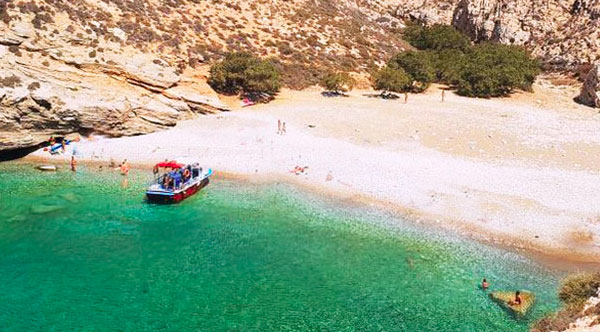
See the lemon houses of Folegandros
The lemon houses of Folegandros are fortified micro-towers, which have been built for many years in order to ensure the protection of the fruit growers from the strong north winds of the Aegean. It is a special architectural structure that is very often found in Folegandros and it is important to take a photo, because you also have an Instagram account to maintain.
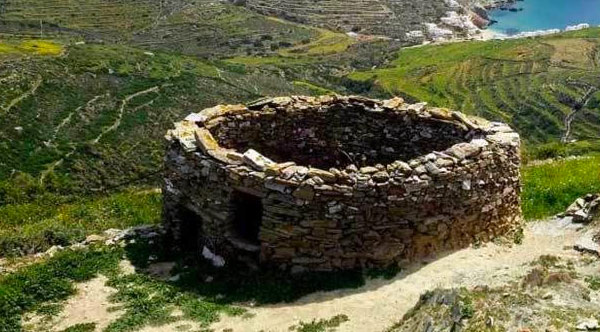
The folegandros festivals
Every summer in Folegandros, small festivals and feasts are set up that aim to highlight the cultural tradition of the island, combining the traditional feast with local gastronomy and which are part of the “Folegandros Festivals” that last from July to October. The Agrosurotoxynotyri Festival together with the Kaikokakavias Festival which takes place a few days earlier, form the duo of culinary events. Through the Agrosourotoxynotyri Festival, an effort is made to promote the agricultural production of the island, especially cheeses.
